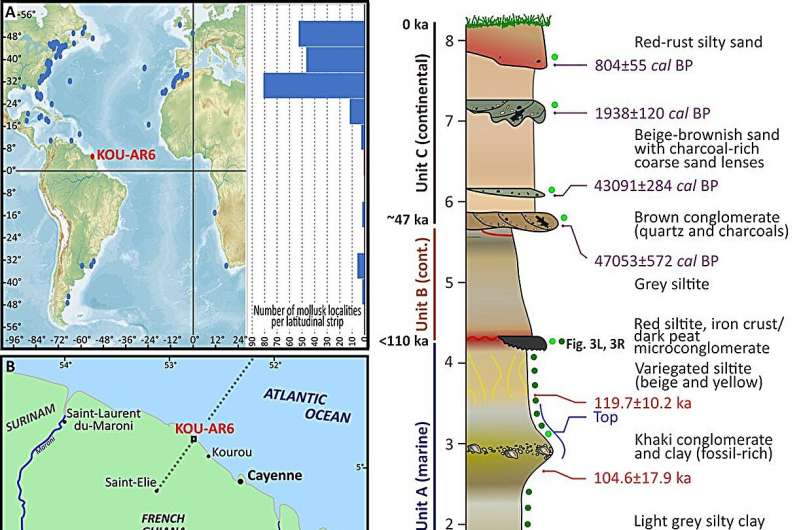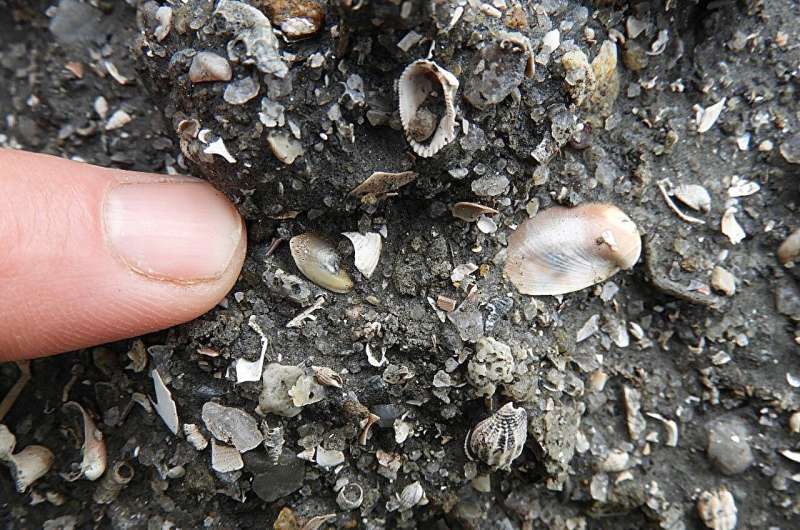This article has been reviewed according to Science X's editorial process and policies. Editors have highlighted the following attributes while ensuring the content's credibility:
fact-checked
peer-reviewed publication
trusted source
proofread
Researchers discover 125,000-year-old coastal ecosystem underneath spaceport in Kourou

In what is an intriguing mix of past and future, an international team of researchers, including some from the University of Bonn, has stumbled upon a surprising window to the past in Kourou in French Guiana. In the clay underneath the new launch pad for the forthcoming Ariane 6 launch vehicle, the interdisciplinary team has uncovered a remarkable collection of fossils stretching back 130,000 years.
Covering over 270 species in total, including bony fish, sharks and numerous plants, they reflect the kind of climatic conditions that calculations suggest are set to reoccur in the year 2100. The team's findings have now been published in the Proceedings of the National Academy of Sciences.
Consisting of more than 270 animal, plant and micro-organism species, these coastal fossils are the first to have been unearthed in the equatorial Atlantic. They provide information about the prevailing environmental and climatic conditions in the region, both during a very warm period in the last interglacial between 128,000 and 116,000 years ago and during the subsequent glacial, i.e., the most recent ice age from 100,000 to 15,000 years ago.
The fluctuations in the climate over the past 2.5 million years have brought about drastic changes in the distribution of organisms across the globe. The last interglacial in particular, which occurred between 128,000 and 116,000 years ago, was characterized by higher sea levels and warmer temperatures than nowadays. This period matches the global conditions being predicted for 2100.
Little if anything was known about the flora and fauna from the equatorial coastal regions of the last interglacial until fossils were discovered in the clay during the construction of Ariane 6's launch pad at Europe's Spaceport in Kourou in French Guiana.
Tens of thousands of fossils were excavated at the site between 2017 and 2021 with the express permission of the Center national d'études spatiales (CNES), France's national space agency. By pooling their expertise, paleontologists, geologists and biologists succeeded in reconstructing the ecosystems that used to exist in French Guiana in precise detail for the first time. The researchers began by characterizing a collection of coastal fossils dating from around 130,000 to 115,000 years ago.

According to the study's two leads, Pierre-Olivier Antoine from the Université de Montpellier and Arnauld Heuret from the Université de Guyane, the reconstructed marine and terrestrial fossil communities contained over 270 species, including foraminifera, mollusks, bony fish, bryozoa, decapods, sharks and numerous plants. All of the fossil specimens found in Kourou belong to modern-day species, some of which are now at risk of extinction.
The findings provide evidence of a brief period of high sea levels during the last interglacial, when the area was home to a mangrove ecosystem and shallow-water habitats that also included some highly diverse communities of mollusks.
According to Austin Hendy from the Natural History Museum in Los Angeles, this diversity shows that there were very strong affinities between the coastal waters of the Caribbean and the Guianas, probably with less influence from mega-currents of Amazonian origin.
Carina Hoorn from the University of Amsterdam explains that the plant fossils discovered on site, including pollens, phytoliths and charcoals, that date from the period after the ocean receded around 110,000 years ago—as the last ice age cooled the planet—suggest that there existed savannas and drier local conditions punctuated by natural fires until around 50,000 years ago.
The investigations by Professor Martin Langer from the Paleontology team in the Institute of Geosciences at the University of Bonn focused on the marine microfossils known as foraminifera, or "forams" for short. These act as a kind of archive for reconstructing the environment, sea levels and sedimentation conditions during the last interglacial between 128,000 and 116,000 years ago.
"Analyzing the microfossils has enabled us to show that sea levels were around 4 to 6 meters higher than they are now, temperatures were about 2°C to 4°C hotter, and the coastline in French Guiana was lined with mangrove forests," the University of Bonn researcher says.
He suggests that the pollens—primarily from grassland—as well as the plant remains and charcoals from younger sediment layers are evidence of the sea receding and conditions becoming drier toward the beginning of the most recent glacial period some 110,000 to 50,000 years ago. The landscape would have been mainly savanna, with occasional wildfires. The charcoals dating from the last few millennia suggest the presence of humans.
"Our findings provide key insights into the ecology and biogeography of undisturbed Pleistocene coastal ecosystems, which are particularly important in view of human-made global heating," Langer explains.
The authors believe that their results will enable a better understanding of the ecology and biogeography of equatorial Atlantic tropical coastal ecosystems prior to any human influence and teach us more about the potential long-term effects of ongoing climate change on the species that are currently endangered. Pierre-Olivier Antoine hopes that "this work will contribute to a better understanding of the major environmental upheavals that the region could experience by 2100."
More information: Pierre-Olivier Antoine et al, A Late Pleistocene coastal ecosystem in French Guiana was hyperdiverse relative to today, Proceedings of the National Academy of Sciences (2024). DOI: 10.1073/pnas.2311597121
Journal information: Proceedings of the National Academy of Sciences
Provided by University of Bonn





















